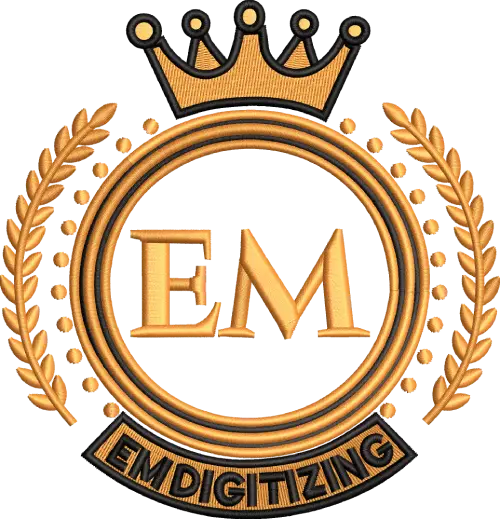Quando si tratta di quale tessuto utilizzare per il ricamo, Non è solo una questione di preferenza, è la differenza tra una finitura impeccabile e un pasticcio frustrante. Se ti è mai capitato che un disegno risultasse storto o raggrinzito, è probabile che il tessuto fosse parte del problema. Così, come si fa la scelta giusta??
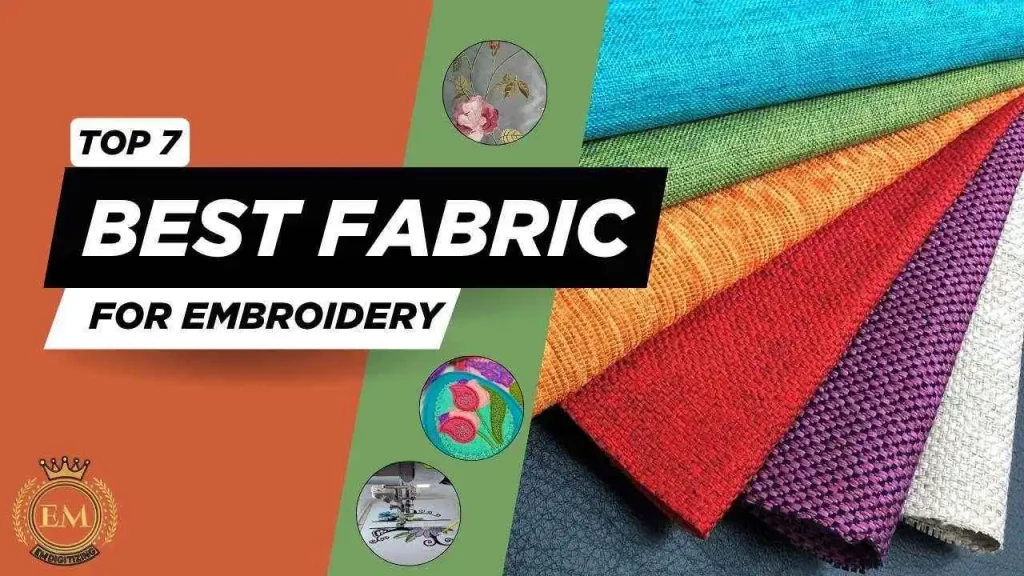
Esaminiamo sette tessuti straordinari che possono migliorare il tuo ricamo a macchina, dalle basi adatte ai principianti ai materiali avanzati per i dettagli decorativi.
Quale tessuto usare per il ricamo | Pick di tessuto superiore?
I migliori tessuti per il ricamo a macchina La nostra scelta
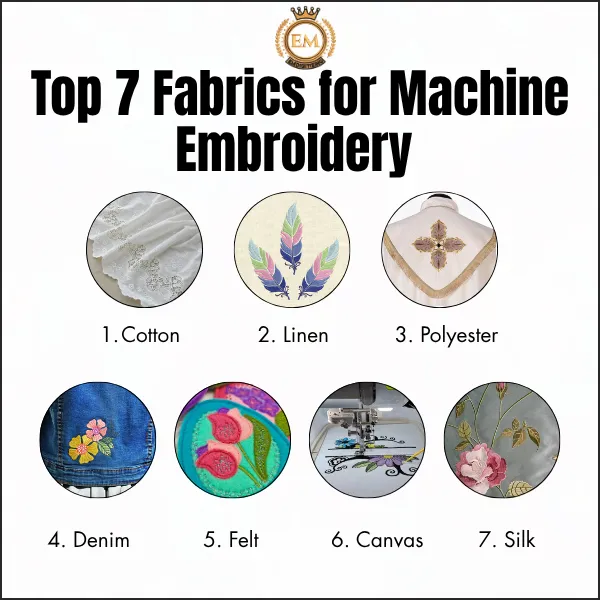
Scegliere il tessuto giusto è la base di un successo ricamo a macchina progetto.
Alcuni tessuti sono più stabili, più facile da intelaiare, e offre una qualità del punto migliore rispetto ad altri.
Ecco i nostri migliori tessuti scelti che forniscono costantemente risultati eccellenti per il ricamo a macchina:
- cotone
- Biancheria
- Poliestere
- Denim
- Sentito
- Tela
- Seta
1. cotone: Il tuo migliore amico del ricamo
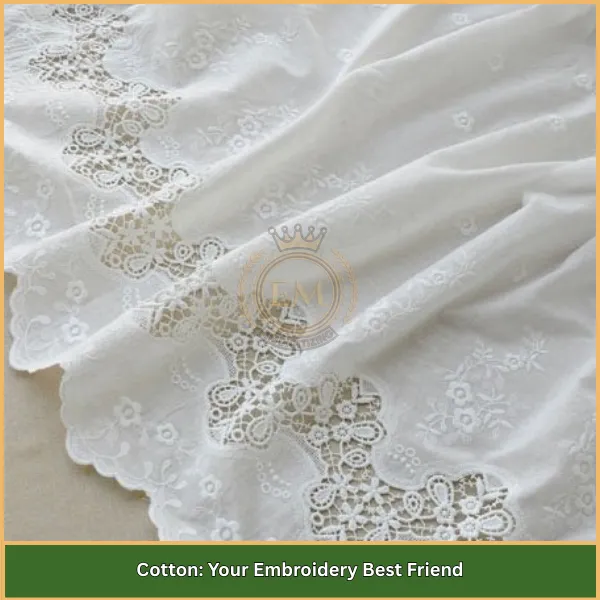
È uno dei più comunemente usati tessuti in ricamo, soprattutto per i principianti. È una fibra naturale nota per la sua consistenza morbida, peso medio, e trama fitta. Queste qualità lo rendono estremamente facile da intelaiare e stabilizzare, aiutandoti a ottenere cuciture pulite e coerenti.
Il cotone è sia leggero che moderatamente denso disegni con facilità e funziona bene con la maggior parte degli stabilizzatori, come strappato o tagliato. Il prelavaggio del cotone è essenziale per prevenire futuri restringimenti, soprattutto se stai realizzando oggetti indossabili.
Il tessuto è disponibile in una varietà di colori, stampe, e il numero di thread, rendendolo versatile per l'arredamento della casa, abbigliamento, e progetti di quilting.
Il prezzo varia da $5 a $12 per metro, a seconda della qualità e della marca.
Vantaggi:
- Facile da intelaiare e preparare
- Ottima chiarezza del punto
- Ampia gamma di pesi e colori
Svantaggi:
- Si restringe se non prelavato
- Si raggrinzisce facilmente
Molti professionisti lo considerano qual è il tessuto migliore su cui ricamare quando si inizia.
2. Tela: Per progetti che necessitano di struttura
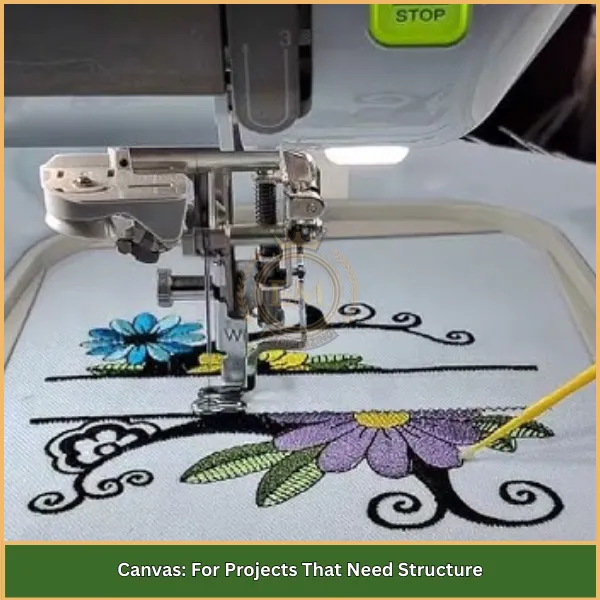
È un tessuto di cotone intrecciato resistente, ideale per i più audaci, ricamo strutturato.
Con il suo spessore, struttura durevole, la tela è la scelta migliore per articoli come le borse tote, arazzi, Banners, e coprisedili.
La rigidità della tela la rende meno adatta a motivi delicati o complessi, ma eccelle nella gestione dell'elevata densità di punti.
Perché intelaiare la tela può essere difficile, molte ricamatrici invece lo fanno galleggiare sullo stabilizzatore.
Funziona bene con uno stabilizzatore rigido da ritagliare e offre uno spostamento minimo durante la cucitura. La trama della tela conferisce ai tuoi progetti una finitura professionale e robusta. Aspettatevi di pagare $6 a $15 per metro, in base al peso e alla miscela.
Vantaggi:
- Contiene disegni di grandi dimensioni senza distorsioni
- Doesn’;t si sposta una volta stabilizzato
Svantaggi:
- Richiede aghi forti
- Può essere troppo spesso per disegni delicati
If you’;stiamo affrontando progetti robusti, questo è probabilmente il il miglior tessuto per il ricamo per risultati duraturi.
3. Sentito: Facile, Conveniente, e adatto ai principianti
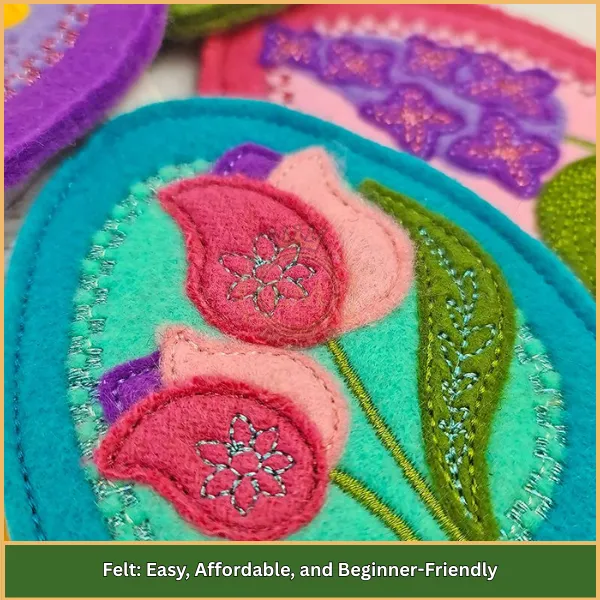
È un tessuto non tessuto realizzato con lana naturale o fibre sintetiche, rendendolo una scelta fantastica per i nuovi ricamatori o artigiani.
È morbido, denso, e non si sfilaccia, eliminando la necessità di rifinire i bordi.
Il feltro è eccellente per piccoli progetti come le toppe, Applique, Portachiavi, distintivi, e ornamenti natalizi.
Supporta disegni semplici con densità di punti leggera. Perché manca una trama, è estremamente facile da intelaiare, and it typically doesn’t require backing unless you’;lo stai usando per uno schema più denso.
Sono disponibili anche fogli di feltro in vari spessori e colori. È estremamente conveniente, di solito un prezzo compreso tra $3 a $8 per metro, o anche meno per i pezzi artigianali più piccoli.
Vantaggi:
- Morbido e stabile
- È richiesta una preparazione minima
- Non necessita di rifinitura dei bordi
Svantaggi:
- Non supporta disegni pesanti o densi
- Può allungarsi leggermente sotto pressione
Questo lo rende ideale per coloro che se lo chiedono quale tessuto viene utilizzato per il ricamo quando si mantengono le cose semplici.
4. Seta: Lussuoso ma impegnativo
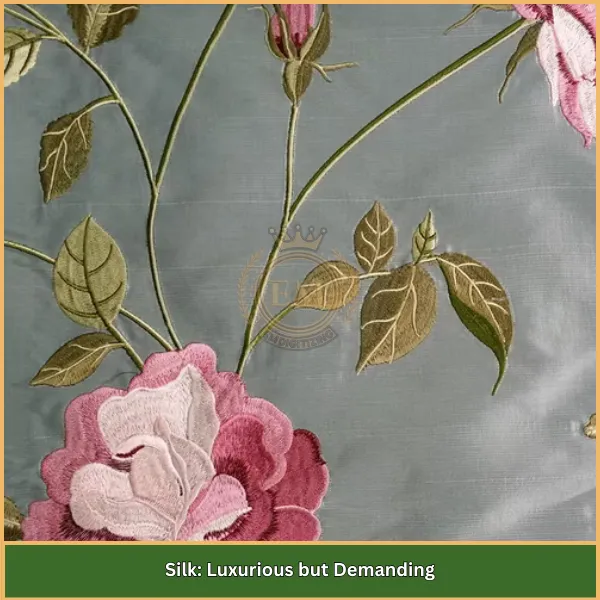
È un peso leggero, liscio, e tessuto lussuoso, amato per la sua lucentezza naturale e la finitura elegante.
Viene spesso utilizzato nei ricami di fascia alta o decorativi come i pezzi da sposa, opera d'arte incorniciata, o regali di cimelio.
Tuttavia, la seta è delicata e può essere facilmente danneggiata da un telaio stretto o da un'elevata densità dei punti.
Invece di intelaiare direttamente la seta, molte ricamatrici lo fanno galleggiare sullo stabilizzatore utilizzando spray o nastro adesivo temporaneo.
Abbinalo a uno stabilizzatore a rete lavabile o invisibile e utilizza sempre aghi sottili per evitare strappi.
La seta richiede velocità della macchina lente e cuciture di prova. Il prezzo della seta varia da $15 a $40 per metro, a seconda del tipo e della qualità.
Vantaggi:
- Finitura elegante con lucentezza naturale
- Ottimo per cuciture decorative delicate
Svantaggi:
- Difficile da incastrare
- Facilmente danneggiabile sotto pressione
Questo lussuoso tessuto risponde alle domande di molti artigiani: che tessuto usi per il ricamo? che necessita di una finitura di fascia alta.
5. Poliestere: Una potenza commerciale
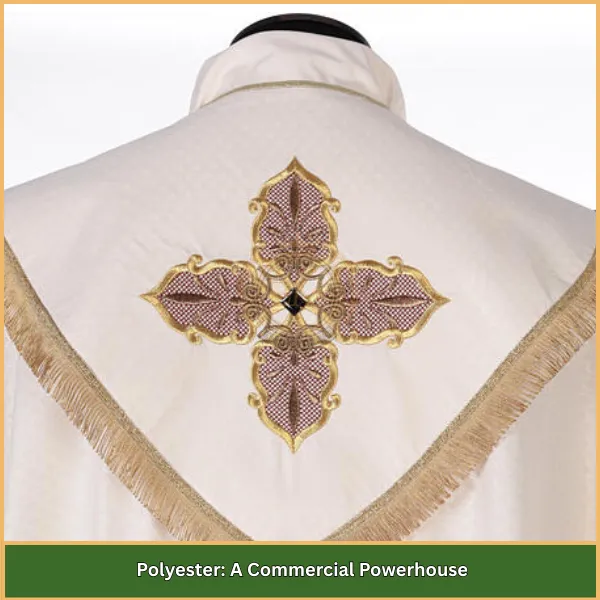
È una fibra sintetica che è diventata un tessuto di riferimento nel ricamo commerciale.
Si trova comunemente nell'abbigliamento sportivo, uniformi, freddo, e abbigliamento promozionale. Il poliestere è leggero, forte, Colorfast, e resistente al restringimento e alle rughe.
Supporta design a densità da leggera a media e funziona meglio con stabilizzatori come mesh anti-esposizione o a strappo. Tuttavia, ha una consistenza scivolosa, quindi è importante intelaiare o galleggiare con attenzione.
Poiché è sensibile al calore, dovresti sempre testare le impostazioni di stiratura.
Le miscele di poliestere sono particolarmente apprezzate per la loro durata e capacità di resistere a lavaggi frequenti. I prezzi generalmente vanno da $3 a $10 per metro, a seconda della qualità.
Vantaggi:
- Non si restringe né si raggrinzisce
- Ideale per produzione in serie e durevolezza
Svantaggi:
- Può spostarsi nel cerchio
- Sensibile al calore e richiede una stiratura a bassa temperatura
Many production shops agree it’;è il miglior tessuto su cui ricamare quando si esegue un lavoro ripetuto.
6. Biancheria: Per un look naturale e strutturato
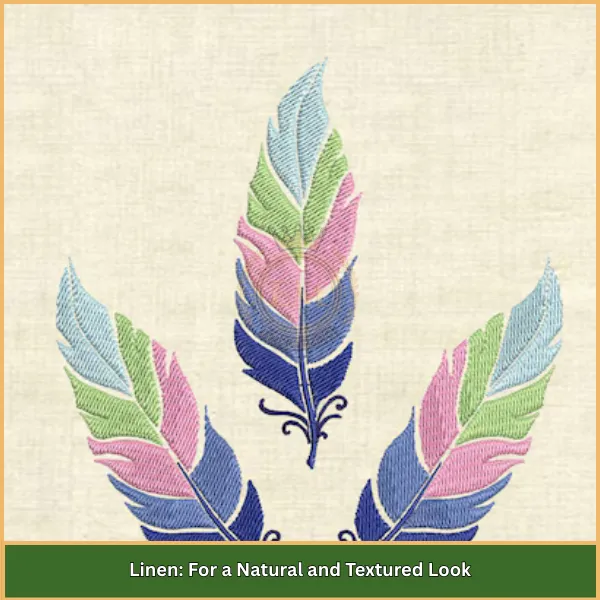
È una fibra naturale ricavata dal lino, amata per il suo fascino vintage e la sua consistenza traspirante.
Ha una trama leggermente più larga rispetto al cotone, ma può trattenere bene i punti di ricamo se opportunamente stabilizzato.
Il lino è perfetto per i monogrammi, cuciture cimelio, ed eleganti decorazioni per la casa come strofinacci, corridori, e arte della parete.
Tende a sfilacciarsi più facilmente, quindi si consiglia la finitura dei bordi.
Utilizza sempre uno stabilizzatore forte e valuta la possibilità di inamidare il tessuto prima di cucire per migliorarne la maneggevolezza.
Anche il prelavaggio è importante per ridurre il restringimento. La biancheria in genere costa $10 a $25 per metro, a seconda del numero di fili e della miscela.
Vantaggi:
- Naturale, aspetto strutturato
- Comodo e classico
Svantaggi:
- Tessuto sciolto e si sfilaccia facilmente
- Richiede un'adeguata stabilizzazione
Alla ricerca di fascino e tradizione? Questo potrebbe essere quale tessuto è migliore per il ricamo con un'atmosfera storica.
7. Denim: Resistente e di tendenza
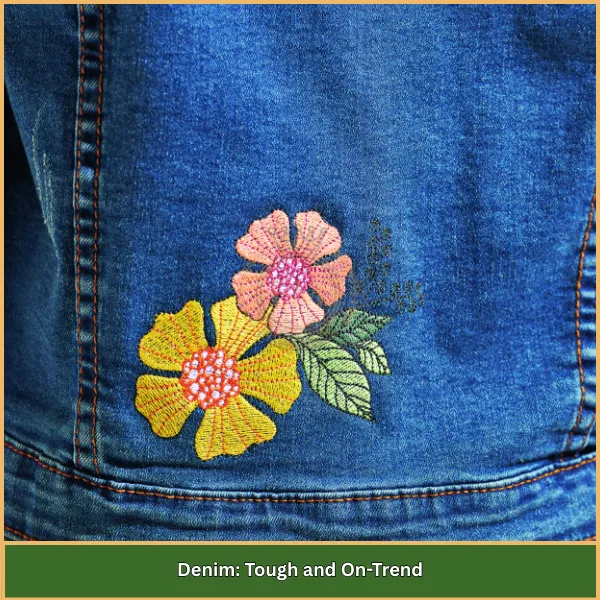
È un tessuto in twill di cotone pesante che conferisce resistenza e stile al ricamo.
È comunemente usato per le giacche, jeans, borse di tela, grembiuli, e accessori.
La trama fitta del denim supporta i disegni a punto pesante, rendendolo ideale per grafica e patch audaci.
A causa del suo spessore, richiede un ago robusto (90/14 o più alto) e un forte stabilizzatore tagliato.
Intelaiare il denim può essere difficile, quindi alcuni utenti preferiscono spostarlo.
Potrebbe essere necessario ridurre la velocità della macchina per ottenere risultati migliori. Il denim resiste ai lavaggi e all'usura frequenti. Il prezzo in genere varia da $7 a $18 per metro, a seconda del peso e della qualità.
Vantaggi:
- Ottimo per cuciture fitte e durata
- Elegante e duraturo
Svantaggi:
- Difficile da fare a canestro
- Richiede velocità del punto più lente e aghi più forti
Spesso si distingue come una scelta solida per quale tessuto utilizzare per il ricamo quando si lavora su abbigliamento o attrezzatura.
Errori comuni nella scelta del tessuto da utilizzare per il ricamo
Molti principianti commettono gli stessi errori quando scelgono il tessuto, che possono influire sulla qualità del ricamo. Ecco quelli più comuni:
- Scegliere un tessuto elastico senza stabilizzatore: Tessuti elasticizzati come jersey o spandex possono distorcere i disegni se non abbinati a uno stabilizzatore ritagliabile.
- Saltare il prelavaggio: Tessuti come cotone e lino si restringono dopo il lavaggio. Se non prelavato, il tuo disegno potrebbe arricciarsi dopo il primo lavaggio.
- Usare tecniche di intelaiatura scorrette: Tirare il tessuto troppo stretto o allentato nel telaio provoca cuciture irregolari o bruciature sul telaio.
- L'ago non corrisponde al tessuto: L'uso del tipo o della dimensione dell'ago sbagliato può lasciare dei buchi, rompere i fili, o danneggiare il tessuto.
Design troppo denso per il tessuto: Le cuciture pesanti su tessuti leggeri possono causare arricciature e strappi. Abbina sempre la densità del design alla resistenza del tessuto.
Suggerimenti per la risoluzione dei problemi relativi al tessuto da utilizzare per il ricamo
Ancora problemi dopo aver selezionato il tessuto? Ecco soluzioni comprovate:
- Arricciature dopo la cucitura: Ciò è spesso causato da intelaiature allentate o stabilizzatori deboli. Utilizza uno stabilizzatore da tagliare e assicurati che il tessuto sia ben stretto nel telaio.
- Il tessuto scivola nel telaio: Comune con tessuti lisci come seta o poliestere. Avvolgi il telaio interno con del nastro twill o fai galleggiare il tessuto usando il nastro da ricamo.
- Design non allineato correttamente: Causato da un tessuto instabile o da una velocità del punto troppo elevata. Utilizzare uno stabilizzatore rigido e ridurre la velocità.
- Fori degli aghi nel tessuto: Ciò accade su tessuti delicati quando si utilizza un ago grosso o smussato. Usa un diesis, ago di dimensioni più piccole e ridurre la densità del punto.
- Il tessuto elastico provoca disegni ondulati: Utilizzare sempre uno stabilizzatore da tagliare ed evitare di allungare il tessuto durante l'intelaiatura.
Confronto rapido del miglior tessuto per il ricamo a macchina
Tessuto | Texture &; Tatto | Livello di durabilità | Facilità di intelaiatura | Progetti ideali | Punta stabilizzatrice |
cotone | Liscio e traspirante | Moderare | Molto facile | Tovaglioli, Magliette, blocchi trapuntati | Strappo o taglio |
Tela | Solido e strutturato | Molto alto | Stimolante (galleggiante) | Borse tote, Home decor, Banners | Spaccato |
Sentito | Morbido e denso | Da basso a moderato | Molto facile | Cerotti, applicazione, piccoli mestieri | Opzionale o a strappo |
Seta | Morbido con lucentezza naturale | Basso | Molto difficile | Accessori da sposa, arte incorniciata | Rete invisibile o lavabile |
Poliestere | Scivoloso ed elastico | Alto | Moderare | Uniformi, abbigliamento sportivo, abbigliamento commerciale | Rete invisibile o a strappo |
Biancheria | Ruvido e traspirante | Moderare | Moderare | Monogrammi, decorazioni cimelio | Spaccato |
Denim | Spessa e robusta | Molto alto | Difficile | Giacche, jeans, zaini | Spaccato |
Verdetto finale
Ormai, hai visto quella scelta quale tessuto utilizzare per il ricamo influisce su ogni parte del progetto finale, dall'intelaiatura alla durabilità. Seleziona in base alle tue esigenze di progettazione, prova la tua configurazione, e prepara il tessuto in modo intelligente.
Ricorda, che si tratti di un progetto hobby o di un pezzo professionale, EMdigitizing può rendere il tuo disegno adatto perfettamente. Offriamo digitalizzazione personalizzata ottimizzata per il tuo tipo di tessuto con qualità garantita, 24/7 supporto, e un 50% sconto sul tuo primo ordine.
Così Ordina ora e sperimenta te stesso!
Domande frequenti
Un tessuto di peso medio, fra 150–250 GSM, è meglio per il ricamo. Non è troppo spesso o troppo sottile. Tiene bene i punti ed è facile infilarci un ago. Questo lo rende adatto sia al ricamo a mano che a macchina.
I tre tipi principali sono:
- Tessuti (come cotone e lino) – Ideale per stabilità e facilità di cucitura
- Tessuti non tessuti (come feltro) – Ottimo per creare patch
- Tessuti a maglia (come la maglia) – Può funzionare bene con uno stabilizzatore e una cura
I tessuti intrecciati sono la scelta più semplice e comune.
sì, puoi ricamare su quasi tutti i tessuti purché un ago possa attraversarli. Ma è meglio iniziare con tessuti non elasticizzati come cotone, biancheria, o tela. Questi sono più facili da lavorare, soprattutto per i principianti.
Il tessuto dietro il tessuto principale si chiama a stabilizzatore o supporto per ricamo. Supporta i punti e impedisce al disegno di muoversi o stropicciarsi. Uso supporto a strappo per tessuti resistenti e supporto ritagliato per quelli elastici o sottili
Scegli un di peso medio, tessuto a trama fitta realizzati con materiali naturali come cotone o lino. Anche, pensa a come verrà utilizzato l'oggetto, scegli durevole, tessuto irrestringibile se verrà lavato o indossato spesso. Un buon tessuto aiuta il tuo design a durare più a lungo e ad avere un aspetto migliore.
